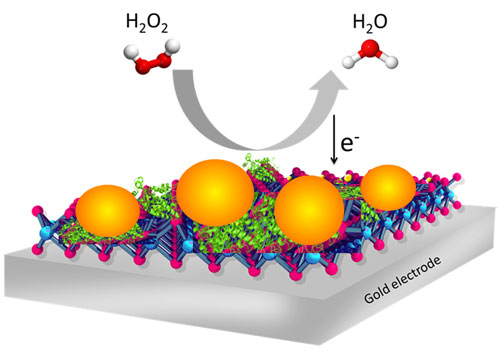| Posted: May 21, 2014 | |
High-throughput electrocatalytic nano-bioreactors on graphene-like atomic thick surface |
|
| (Nanowerk Spotlight) Nanobioreactors are emerging as advanced bio-devices, which fuse the advantages of nanomaterials with those of nanobiotechnology. Due to their ultimately small size, high surface area and simulation capacity, they are set to become to be a versatile tool to fabricate ultra-sensitive and selective novel nanobio-devices, which offer us new platform to tackle key energy, medical and environmental issues. | |
| Current nanobioreactor researches are focused on the designing of simple-to-use, inexpensive bio-devices, which could be highly selective, sensitive and stable. However, current designs mostly suffer from a lack of efficiency and sensitivity. | |
| In new work, the Smart Materials and Biodevice Group lead by Prof. Ashutosh Tiwari, Linkoping University, Sweden reported for the first time ("Two-Dimensional Gold-Tungsten Disulphide Bio-Interface for High-Throughput Electrocatalytic Nano-Bioreactors") the fabrication of novel two-dimensional (2D) bioreactor consisting of gold nanoparticle-structured graphene-like atomic thick surface of tungsten disulphide (WS2) nanosheets, which offer a simple and effective way to overcome many limitations that have been faced by previous designs. | |
| Using electrochemical techniques, they demonstrated that 2D electrocatalytic bio-interfaces can be implemented to produce and regulate biological reactions for novel bioreactor, biofuel cell and biosensor applications. | |
 |
|
| Figure 1: Schematic representation of gold nanoparticles (Au NPs)-structuring on a WS2 interface and electron transfer process in the WS2/Au NPs/enzyme nanobioreactors on the gold electrode. (Image: Smart Materials and Biodevice Group, Linkoping University) | |
| Figure 1 illustrates the overall process for the structuring of the gold nanoparticles arrays on WS2 nanosheets and enzyme based hybrid structure for high order enzymatic evolution of H2O2. | |
| The synthesis strategy is to initially obtain self-assembled WS2/Au NP hybrid nanosheets on a gold electrode surface. This is the crucial step to achieve free-standing and stable dispersion for further enzyme assembly. | |
| The second step involves the conjugation of the enzyme with WS2/Au NP nanosheets to acquire an orderly self-assembled bio-interface. | |
| The results have shown that bioelectrocatalytic reactions can be controlled and regulated by modifying the nanointerface. The material we have designed could potentially provide significant improvements in biocatalysis and nanotechnology by exploiting this novel biocatalytic interface. | |
|
By Onur Parlak, Prethi Seshadri, Ingemar Lundström, Anthony P.F. Turner and Ashutosh Tiwari, Biosensors and Bioelectronics Centre, Linköping University, Sweden.
|
|
|
Become a Spotlight guest author! Join our large and growing group of guest contributors. Have you just published a scientific paper or have other exciting developments to share with the nanotechnology community? Here is how to publish on nanowerk.com. |
|
